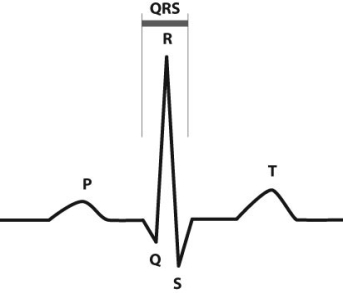Multiple Choice
Electrocardiographs (ECGs or EKGs) provide data about the electrical activity of the heart. By placing a series of "leads" on a person's chest, the electrical activity of the heart can be recorded and analyzed in order to detect irregular heartbeats (arrhythmias) and other conditions. The figure below shows a normal EKG tracing for one cardiac cycle.
 The P region represents electrical activity spreading through the atria. The QRS region represents electrical activity spreading through the ventricles. The T region represents electrical activity in the ventricles returning to rest.
The P region represents electrical activity spreading through the atria. The QRS region represents electrical activity spreading through the ventricles. The T region represents electrical activity in the ventricles returning to rest.
-What is happening in the heart during the QRS region?
A) The atria are filling with blood.
B) The ventricles are filling with blood.
C) The atria are contracting.
D) The ventricles are contracting.
Correct Answer:

Verified
Correct Answer:
Verified
Q64: To evaluate cardiac function, scientists and physicians
Q65: Which of the following is a function
Q66: Ron and Tiffany are studying circulatory
Q67: At any given time, what percentage of
Q68: During which phase of the heartbeat do
Q70: The main function of the AV node
Q71: To evaluate cardiac function, scientists and physicians
Q72: Which of the following is the cause
Q73: During exercise, your cardiac output can increase
Q74: Hematocrit is the percentage of red blood